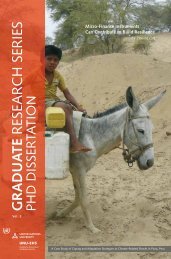Unveiling Women as Pillars of Peace Peace Building in ...
Unveiling Women as Pillars of Peace Peace Building in ...
Unveiling Women as Pillars of Peace Peace Building in ...
You also want an ePaper? Increase the reach of your titles
YUMPU automatically turns print PDFs into web optimized ePapers that Google loves.
Politicians have perfected the art <strong>of</strong> manipulat<strong>in</strong>g ethnicity to strengthen their positions <strong>as</strong><br />
ethnic leaders rather than national leaders. They <strong>of</strong>ten play on ethnic sentiments, fears and<br />
sensitivities to secure their positions. Therefore, politicisation <strong>of</strong> ethnicity h<strong>as</strong> become the<br />
strongest s<strong>in</strong>gle determ<strong>in</strong>ant <strong>in</strong> the doma<strong>in</strong> <strong>of</strong> governance <strong>in</strong> Kenya. While the political elite use<br />
their ethnicity to enhance both their political power and their wealth, the m<strong>as</strong>ses are <strong>in</strong>duced <strong>in</strong>to<br />
distrust and fear <strong>of</strong> other ethnic groups, particularly those who belong to political parties different<br />
from their own. Without democratic <strong>in</strong>stitutions with which people can identify, or competent<br />
security and legal structures to which people can appeal to for their claims, these feel<strong>in</strong>gs further<br />
consolidate the position <strong>of</strong> leaders <strong>as</strong> ethnic spokespersons.<br />
Consequences <strong>of</strong> Conflict<br />
The extent <strong>of</strong> the effects <strong>of</strong> conflict on Kenya’s populations is uncerta<strong>in</strong> and speculative.<br />
Register<strong>in</strong>g displaced persons is difficult for both logistical and political re<strong>as</strong>ons (Rogge 1993).<br />
Many victims rema<strong>in</strong> undocumented, leav<strong>in</strong>g large numbers outside <strong>as</strong>sistance networks. For<br />
<strong>in</strong>stance, by 1993, most victims were reluctant to register with government <strong>in</strong>stitutions because<br />
they did not trust the state and its functionaries. Typically, victims have disappeared and<br />
gravitated towards urban centres. Population growth is noticeably up <strong>in</strong> towns near conflict are<strong>as</strong>.<br />
The dramatic <strong>in</strong>cre<strong>as</strong>e <strong>in</strong> the numbers <strong>of</strong> street children and homeless families is an <strong>in</strong>dication <strong>of</strong><br />
this migration phenomenon.<br />
The most cited estimates <strong>of</strong> cl<strong>as</strong>h victims <strong>in</strong>dicate 1,500 by early 1993. More than<br />
350,000 people, largely but not exclusively from the Rift Valley and Western prov<strong>in</strong>ces, were<br />
displaced to camp-like situations, usually <strong>in</strong> church compounds, schools and market places (Rogge<br />
1993, HRW 1997). These numbers exclude an estimated 100 dead and 100,000 persons displaced<br />
<strong>in</strong> the ethnic cl<strong>as</strong>hes that occurred <strong>in</strong> August 1997 <strong>in</strong> Momb<strong>as</strong>a. Of those displaced, 210,000<br />
rema<strong>in</strong>ed so by early 1998. Comment<strong>in</strong>g on the prolonged displacement <strong>in</strong> the Rift Valley, on 9<br />
November 1999, President Moi called for the displaced to“ . . . return to their homes and cont<strong>in</strong>ue<br />
with their normal lives.” Only a few have returned to their home are<strong>as</strong>.<br />
By 1993, about 22,300 people were registered <strong>as</strong> displaced <strong>in</strong> the Elgeyo–Marakwet<br />
districts (NEMU Report 1993). These two districts have cont<strong>in</strong>ued to witness sporadic <strong>in</strong>tra-<br />
Kalenj<strong>in</strong> conflicts (NCCK 1997). Between 1997-98 the Pokot–Marakwet conflicts produced<br />
more than 4,000 victims. S<strong>in</strong>ce the beg<strong>in</strong>n<strong>in</strong>g <strong>of</strong> 1999, this area h<strong>as</strong> become the theatre <strong>of</strong> violence<br />
and displacement <strong>of</strong> populations. Between January and March 1998, cl<strong>as</strong>hes <strong>in</strong> Laikipia and Molo<br />
displaced and disrupted the lives <strong>of</strong> many. The numbers are less def<strong>in</strong>ite <strong>in</strong> the nomadic North<br />
E<strong>as</strong>tern prov<strong>in</strong>ce where entire populations are on the move throughout the year. In March 1999, an<br />
<strong>in</strong>cident <strong>of</strong> <strong>in</strong>ter-clan rivalry <strong>in</strong> Wajir left nearly 140 people dead and an unknown number<br />
wounded.<br />
Other are<strong>as</strong> prone to cl<strong>as</strong>hes and displacement are away from the pry<strong>in</strong>g eye <strong>of</strong> the media<br />
and rema<strong>in</strong> largely unreported. For example, s<strong>in</strong>ce January 1998, more than 1,000 people have<br />
been displaced <strong>in</strong> the Tharaka-Nithi Nyabene belt. Tana River, parts <strong>of</strong> Migori and northern<br />
Mw<strong>in</strong>gi are are<strong>as</strong> that have witnessed systematic depopulation <strong>as</strong> people flee attacks from bandits.<br />
In each <strong>in</strong>stance, the conflict h<strong>as</strong> led to substantial loss <strong>of</strong> human life and destruction <strong>of</strong><br />
livestock and other property. Therefore, the cl<strong>as</strong>hes have created a large <strong>in</strong>ternally displaced<br />
population <strong>of</strong> destitute and highly vulnerable Kenyans. Many thousands <strong>of</strong> homes have been<br />
destroyed, and the majority <strong>of</strong> the displaced populations have lost most, if not all <strong>of</strong> their<br />
household effects, food stocks, agricultural implements, seed, and livestock. Large reserves <strong>of</strong><br />
15



